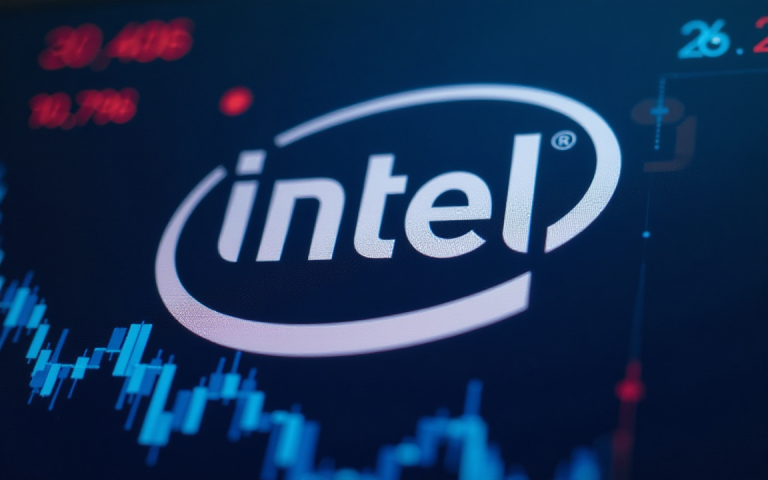Intel Corp (NASDAQ: INTC) forecast lower-than-expected revenue and profit for the second quarter, unsettling investors during new CEO Lip-Bu Tan’s first earnings report at the helm.
The announcement comes amid escalating Sino-US trade tensions and growing uncertainty around global semiconductor demand, which the company says could trigger a broader economic slowdown.
Shares of the US chipmaker slid 5.82% in premarket trading following the downbeat forecast, as Wall Street digested the twin challenges of weakening demand and geopolitical uncertainty.
Tariff-driven buying lifts Q1 but clouds Q2
In the first quarter, Intel reported stronger-than-expected sales, which CFO David Zinsner attributed to customers rushing to buy chips before potential price hikes due to tariffs.
“We will certainly see costs increase and we feel it prudent to anticipate a contraction,” Zinsner told analysts during a post-earnings call.
“The biggest risk we see is the impact of a potential pullback in investment and spending.”
Intel’s guidance for the June quarter was broader than usual, reflecting a highly uncertain environment shaped by shifting trade policies and volatile consumer sentiment.
The company warned that while chip prices remain exempt from US tariffs, retaliatory measures from China—its largest market—could result in levies of 85% or more on US-made chips.
Older chips see a surge in demand amid economic jitters
While new chip sales remain under pressure, Intel has seen a sharp uptick in demand for older-generation processors, particularly in the personal computer and server markets.
Michelle Johnston Holthaus, head of Intel’s client and data center unit, said customers were choosing legacy chips as a hedge against uncertain economic conditions.
“Macroeconomic concerns and tariffs have everybody hedging their bets,” Holthaus said.
“We are seeing strong demand on older-gen parts in both client and data center segments.”
That demand may offer a short-term lifeline but could also delay adoption of Intel’s upcoming AI-focused chips designed for next-generation PCs.
Analysts praise cost-cuts but flag tariff-driven headwinds
Despite the bleak forecast, Intel drew some praise for its aggressive cost-cutting strategy.
The company is reining in capital expenditures and slashing operational spending across marketing and R&D.
“While we applaud the enhanced cost-cutting efforts, share loss is an issue while the planned second-half ramp of Intel 18A will be crucial,” wrote CFRA Research analyst Angelo Zino.
“We think Intel remains in a tough position, as competitive pressures across the PC and server markets only intensify, with the company lacking the proper offerings to successfully compete, in our view.”
Other analysts expressed similar reservations:
JP Morgan maintained an “underweight” rating with a $20 price target, projecting a softer seasonal performance in the second half due to persistent headwinds from tariffs and trade uncertainty.
Morgan Stanley, which rates the stock “equal weight” with a $23 target, noted that while Intel’s focus has been on advancing process technology, it has yet to address deeper product shortcomings.
The firm suggested Intel could benefit from a more balanced approach that includes both manufacturing improvements and design innovation, as practiced by rivals like TSMC.
Evercore ISI, also at “in line” with a $23 target, said the new CEO has made a solid start but still faces significant operational challenges.
“The new CEO has a lot of wood to chop, it looks like he has started off on the right foot, but we remain on the sidelines and could get more constructive with evidence of execution and improvement in market share,” the brokerage said.
Intel layoffs: what do analysts say about restructuring?
Another key development was Intel’s announcement on layoffs.
While the company confirmed it will eliminate certain layers of management, it stopped short of providing specific job cut numbers.
This followed a Bloomberg report suggesting Intel may slash over 20% of its workforce.
The layoffs are part of a broader cost-reduction strategy.
Intel has trimmed its operating expense target by $500 million for this year and anticipates another $1 billion in savings next year.
However, the move has done little to reassure investors about the company’s deeper challenge: defending and regaining market share from competitors like AMD and Nvidia.
“INTC’s core PC and traditional server markets appear ex-growth. Tariffs [are] putting extra pressure on PC…We expect continued server CPU share loss this year. IFS [Intel’s chip-manufacturing division] remains unprofitable for the foreseeable. Management focused near term on restructuring/streamlining. We remain sidelined here,” wrote Oppenheimer analyst Rick Schafer in a research note.
Schafer has a Perform rating on Intel stock with no target price.
Trade war risks compound macroeconomic concerns
Adding to the headwinds is the broader economic environment, where fears of a recession are growing.
Zinsner warned that “fluid trade policies in the US and beyond” have increased the probability of a slowdown, noting that higher input costs from tariffs will likely weigh on Intel’s margins.
The company had hoped to benefit from a rebound in the PC market later this year, driven by AI adoption and a new Microsoft Windows cycle.
However, analysts say the focus on cheaper chips could derail those plans.
“In a shaky economic climate, ‘good enough’ beats bleeding edge,” said Michael Ashley Schulman, CIO at Running Point Capital. “That’s a macro signal that shouldn’t be ignored.”
Intel’s near-term prospects hinge on successfully navigating trade policy turbulence, regaining product competitiveness, and executing a delicate turnaround under new leadership.
For now, uncertainty remains the dominant theme.
The post Weak Q2 guidance drags Intel shares; analysts cite tariffs, shrinking market share as ongoing risks appeared first on Invezz










